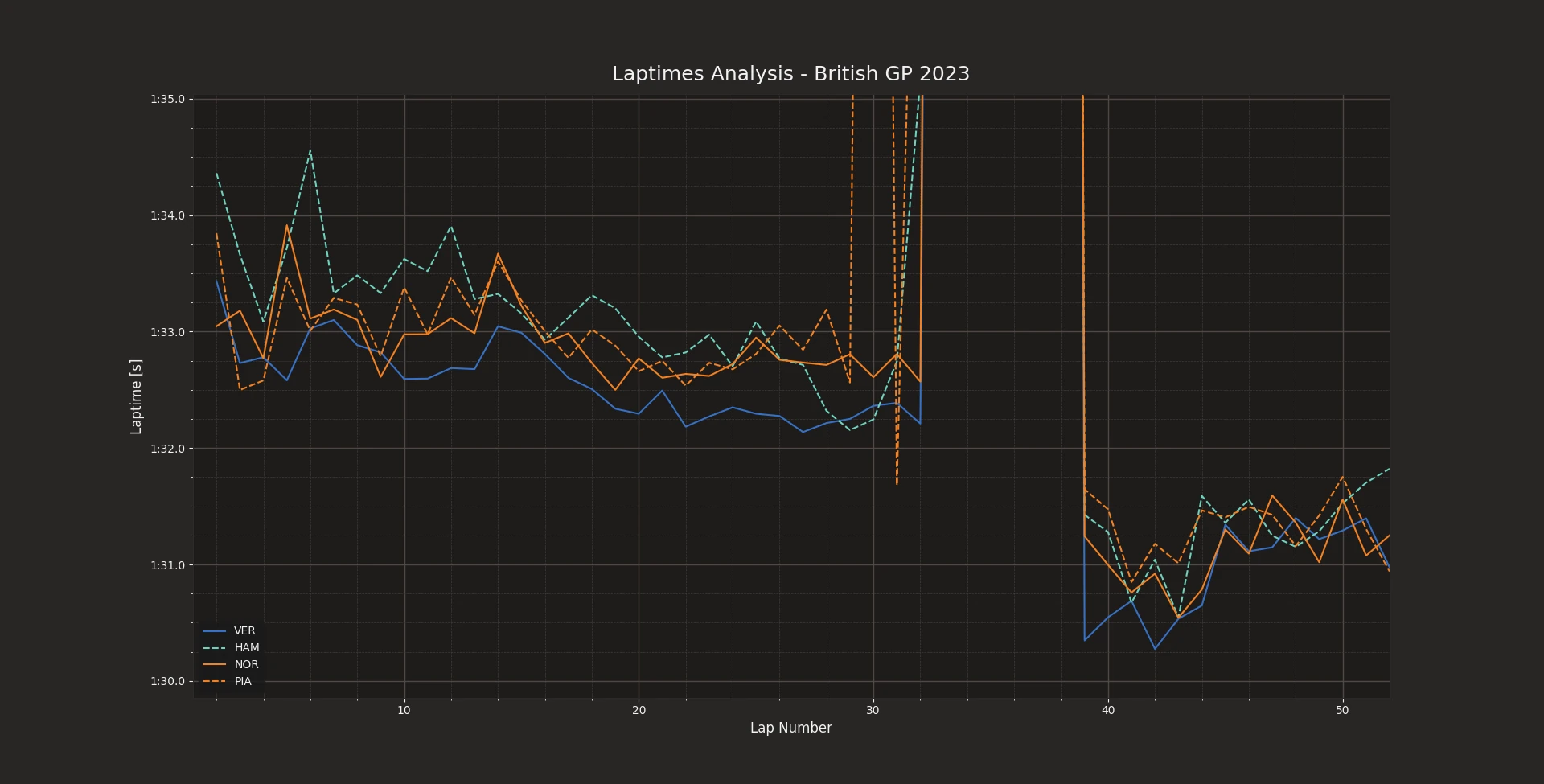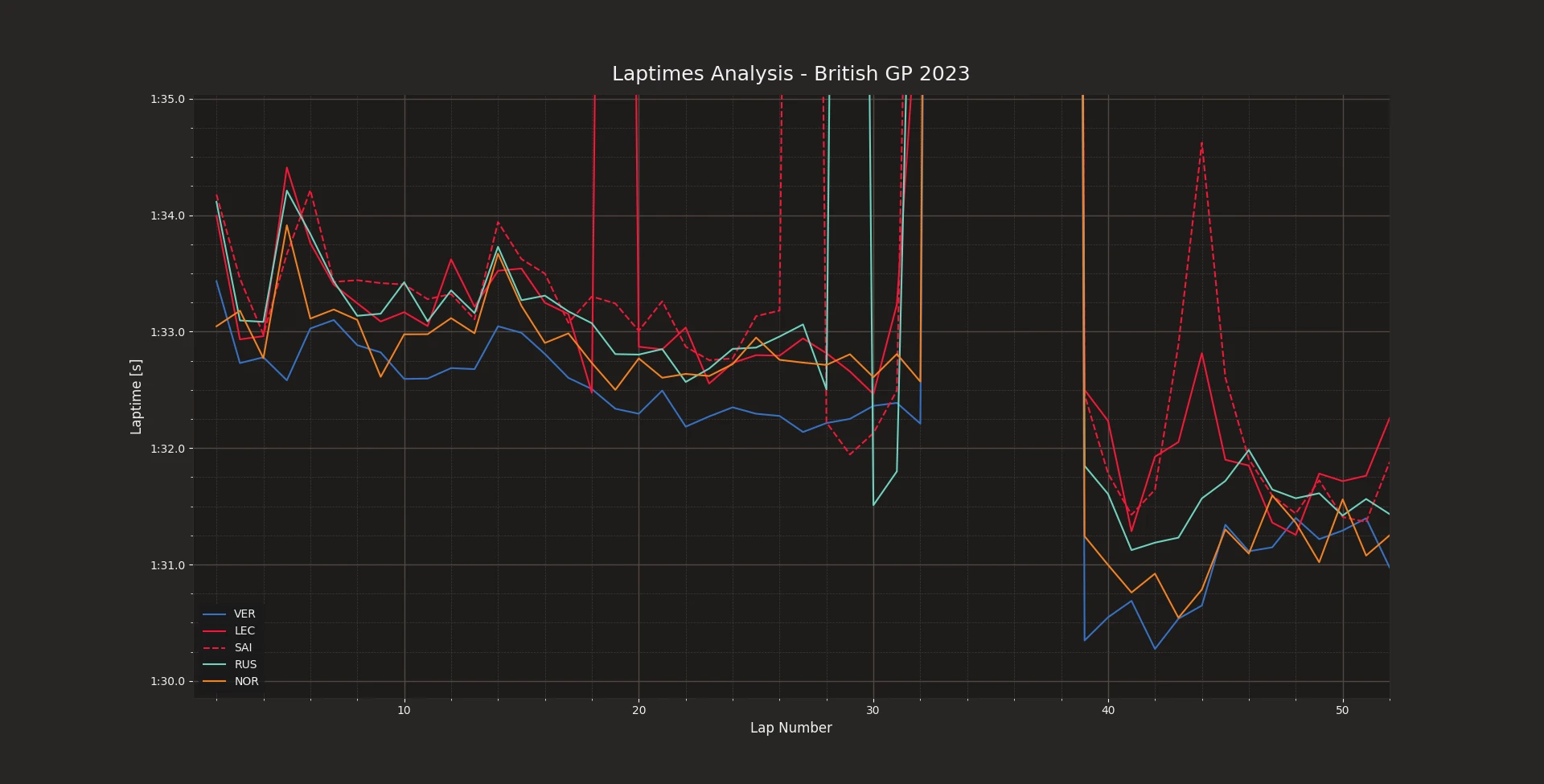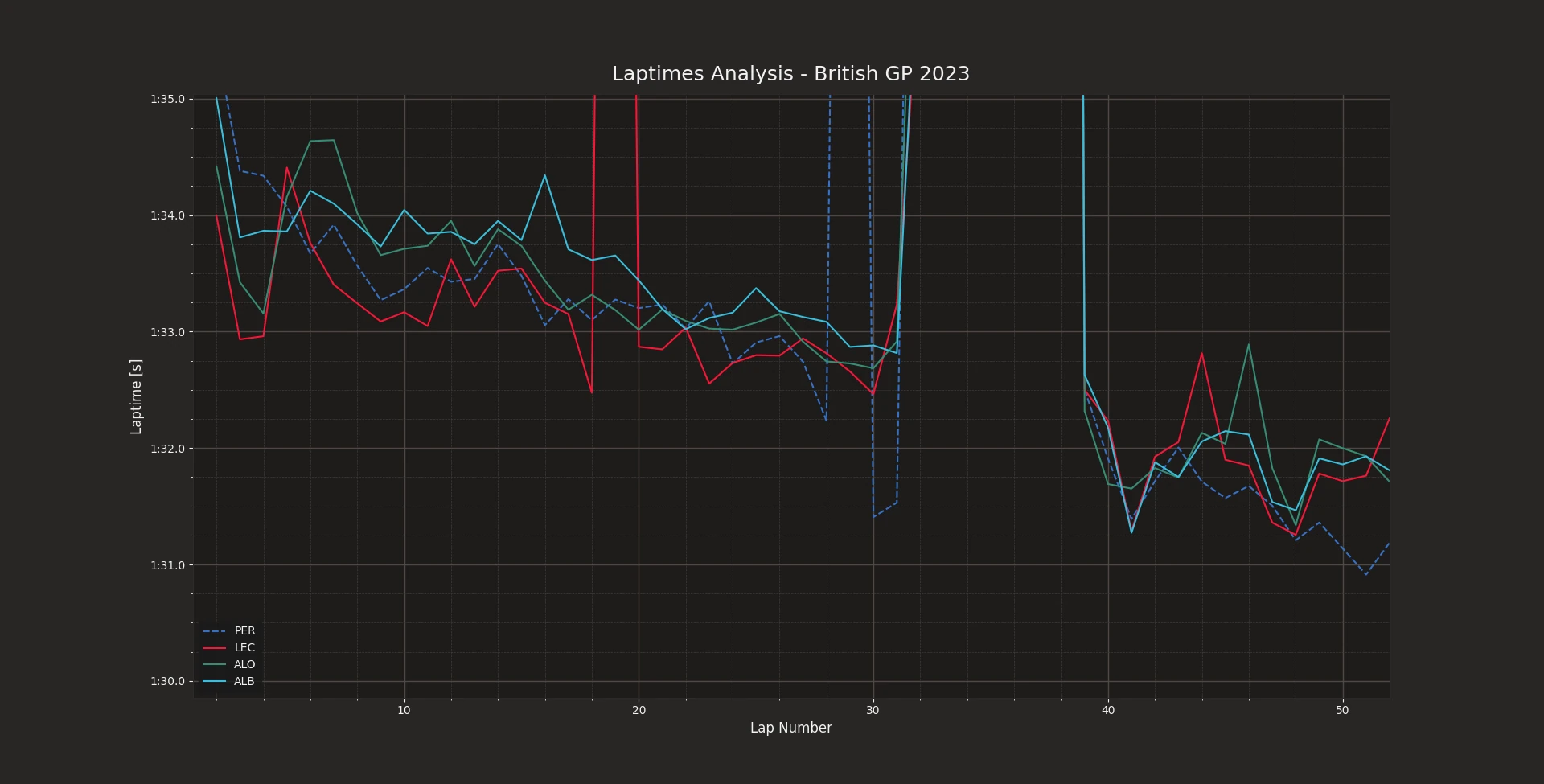
Nothing to do against Verstappen at Silverstone, but Norris and McLaren celebrate!
(Cover picture: Randy Singh - Twitter)
As he has already abundantly accustomed us to, Max Verstappen wins the British Grand Prix and takes his eighth success in ten races held this year: having finished second in the other two rounds, we can certainly state that this is the best season so far, not only in his career, but among any other driver in the history of Formula 1. An impressive statistic that seems to give no respite to the opponents.
"It wasn't such a linear race: in the first stint when I took the lead, things went well and I pulled away... But after the Safety Car we put on the Softs and they overheated quickly, so I wasn't able to get away as I wanted to. I'm glad we won again, eleven victories in a row for the team is something incredible! Now we have to keep doing what we're doing, because things are going great!"
Max Verstappen
Behind him we find Lando Norris and Lewis Hamilton, but before analyzing the race here's the final classification from Silverstone:
How we crossed the line after 52 scintillating laps around Silverstone#BritishGP #F1 pic.twitter.com/aoEDDRfdTL
— Formula 1 (@F1) July 9, 2023
The Grand Prix' plot focused on the strategic factor of tyre management: at the opposite to what was recommended by Pirelli before the race, almost everyone preferred a single pit stop strategy, not ruling out the use of the Softs (usually not a raceable tyre as it wears out very quickly).
ℹ️ #BritishGP pit stop summary
— Pirelli Motorsport (@pirellisport) July 9, 2023
A one-stop race for most, with many drivers taking advantage of the VSC/SC at the two-thirds mark #Fit4F1 pic.twitter.com/gSQZgbC7J6
Let's analyze the race by trying to answer some questions that arose at the end of the 52 laps on the Silverstone track...
Hamilton on the podium thanks to the Safety Car or because he was quicker than Piastri?
The real surprise of the Grand Prix, as already observed after the qualifying, was the pace that McLaren was able to keep: the laptimes that Norris and Piastri were able to set were the second quickest only behind Verstappen (being the twin RB19 of Perez struggling with yet another disastrous weekend), but it's legitimate to wonder if Lewis Hamilton was fast enough to get the two papaya cars past even without the help of the Safety Car on lap 32.
Jake Grant / Motorsport Images
To answer this question, we can have a look at the performance analysis of the first 4 drivers at the finish line: to make the view easier, the laps under Safety Car conditions have been "cut" away from the graph...

Performance analysis of the British GP: Verstappen, Norris, Hamilton, Piastri
After a start that even saw him taking the lead of the race, Norris spent 5 laps ahead and - after being overtaken by Verstappen - other 5 laps in the Dutch driver's DRS zone. This allowed both him and Piastri, who was following him like a shadow in that phase, to lap about half a second quicker than they would have been able to get out of their MCL60 if they were lapping in clean air.
At that point, Hamilton was lapping 2 to 4 tenths slower than the McLaren pair, and finding himself in seventh position also behind Leclerc, Russell and Sainz, he certainly wasn't a threat as far as the podium places were concerned... Precisely for this reason, from approximately lap 10 to lap 25, he decided not to give his all to save tyres in view of a possible Safety Car - which he could only have exploited by extending his first stint as much as possible.
"Congratulations to Lando and McLaren, which was my family, the team I started out with. Their car was super strong in the high-speed corners, I couldn't keep up even though we had a good battle at restart. The start wasn't the best, but the long run on the Medium tyres was really good. So I think this is a good result for us as a team, knowing we're not that far off. We just need to keep pushing, and we'll be able to reach the guys in front"
Lewis Hamilton
And indeed it did, as Magnussen's Power Unit failure neutralized the race on lap 32: this created the perfect opportunity for Hamilton, who got rid of the two Ferraris, his teammate Russell and Oscar Piastri's McLaren at a stroke, rejoining the track on Soft tyres. At that point Lewis's sights were on Lando's second position, who, like Oscar Pistri, was instead equipped with Hard tyres (that are always more difficult to warm up on the restarts after the Safety Car).
Jake Grant / Motosport Images
In the last 13 laps after the neutralization, opposed to what might have been expected, Norris managed to defend the second step of the podium from Hamilton's attacks, to then even keep him at over 1 second (a condition which couldn't allow him to use the DRS...).
"It's really crazy! I have to thank the team, who did a stratospheric job: none of this would have been possible without their efforts. It's crazy what we've managed to do… They put me on the Hards and I'm still a bit puzzled about that, because I would have liked the Softs, which I think were the more sensible choice for a restart after the Safety Car. However we fought really well with Lewis, I was second and I stayed second, so that's perfectly fine. If we had finished second and third it would have been even better, because I think Oscar would have deserved the podium and without the Safety Car he would have achieved it"
Lando Norris
Therefore, answering the question with which we opened the paragraph, I feel like saying that if Oscar Piastri - who was no slower than Norris throughout the race - had found himself defending the position from Hamilton, his final position would have depended on the outcome of a fight between the two; but if instead the Safety Car had never come out, surely the gap opened up to that point would have kept Oscar far from the potential comeback of Lewis.
Unfortunately, with "ifs" and "buts" you don't win Grands Prix, which is why the Australian from McLaren had to give up what would have been a well-deserved first podium in his career...
Ninth and tenth place for Ferrari: too bad to be true?
Who suffered a lot in terms of tyre management and strategies was Ferrari, which with Leclerc comes home in P9 after starting fourth, and with Sainz in P10 after starting fifth... Also in the case of the Maranello team the Safety Car ruined theit plans, but unlike what happened to Piastri, this time the damage was self-inflicted. Let's understand why.
Zak Mauger / Motorsport Images
First of all, it is necessary to clarify an unwritten rule that has always been in force in Formula 1: performance dictates strategies. In other words, the best strategy on paper is not always the one that leads to the best result; especially when the car isn't as fast as one might expect, it's often necessary to be more aggressive and prioritize the "track position": a fairly elaborate jargon to express a simple concept, that if the opponents are faster than you, the only way you can think of beating them is by keeping them behind you and trying to control the situation!

Performance analysis of the British GP: Verstappen, Norris, Russell, Leclerc, Sainz
When on lap 19 Charles Leclerc was called to the pits to replace his Mediums with Hards after having kept the (faster) Mercedes of George Russell behind him, the Ferrari pitwall didn't stay true to the above-mentioned rule: putting Charles in the conditions of having to complete 33 laps on the Hards meant that strategy dictated performance. A luxury that Ferrari couldn't afford, against a stronger Mercedes in terms of race pace and the tyre management.
“Overall we have less degradation than at the beginning of the season when it was our main problem. But the car is still unstable in the wind (even if less than Miami), and on this matter we knew Silverstone would be difficult for us. Where we lost the most was with the Safety Car and tyre degradation: strategically we were probably too shy, while with Carlos the call was right. We have improved on our biggest weakness since the beginning of the year, which was the instability and the race pace variability... The goal wasn't to improve in qualifying, but with the consistency in the race, where it's clear that we have progressed"
Frederic Vasseur
The Safety Car, as mentioned, then did the rest, relegating Leclerc and Sainz to the last two places in the top 10...

Performance analysis of the British GP: Perez, Alonso, Albon, Leclerc
In this way, Leclerc also finished behind Perez (P6), Alonso (P7) and Albon (P8), despite having been faster than them throughout the first part of the race: as can be seen from the graph above, the the advantage he enjoyed over the fastest of the three - Perez - was on average in the order of 3 tenths of a second per lap.
"Today we didn't have much degradation, but there wasn't so much race pace. We pitted a little early, perhaps because George wanted to do the opposite to us, but if we had stayed on the track he would have pitted... Then we were also unlucky with the Safety Car, in that situation we let many rivals overtake us; after the Safety Car it was impossible to overtake, I had the pace but you couldn't pass because Albon was also in front with the DRS all the laps"
Charles Leclerc
Here too we have to answer the question at the beginning of the paragraph: Ferrari's performance was too bad to be true, but under normal conditions I believe that Leclerc and Sainz would have finished in sixth and seventh position respectively - a potential result that would have been unsatisfactory, because it would have in any case confirmed a slower race pace than McLaren (which, we recall, at the beginning of the year was struggling to get into Q2 in qualifying...).
"We expected the Mercedes to be fast, but not that the McLarens would be as strong! We fluctuate too much depending on the track we're racing on. For Formula 1, it's good that the competitiveness level on the track changes like this from race to race, it's obviously less positive for us, but we know what we need to improve to achieve the performance consistency we've been chasing since the beginning of the season"
Carlos Sainz
What will change in two weeks in Budapest?
The next round of the Formula 1 World Championship will be in Budapest, for the Hungarian Grand Prix. The Hungaroring track, unlike Silverstone, is very twisty and rewards high downforce characteristics - as well as the general ability to get a good grip.
The power provided by the Power Units will be less decisive than elsewhere: this circuit is often spoken of as a Monaco without walls, but it must be said that the technical evolution of recent years has raised the average speeds of the Hungaroring, making it less similar to the layout of the Principality.
James Sutton / Motorsport Images
The performance trends highlighted in the first 10 rounds held so far allow us to depict a ranking of what should be the pecking order in Hungary, given that the introduction of technical updates by any team could distort the value scale observed so far.
Therefore, excluding this eventuality (there are already rumors of an aerodynamic update package ready for the Red Bull RB19), at least in the first half of the standings we should find the following cars:
- Red Bull RB19;
- Aston Martin AMR23;
- Ferrari SF-23;
- Mercedes W14;
- McLaren MCL60;
- Alpine A523;
While saying goodbye, I remind you that you can interact with Race Analysis via our Instagram and Twitter social pages, or enjoy more detailed videos on YouTube. See you soon!
Index
Nothing to do against Verstappen at Silverstone, but Norris and McLaren celebrate!